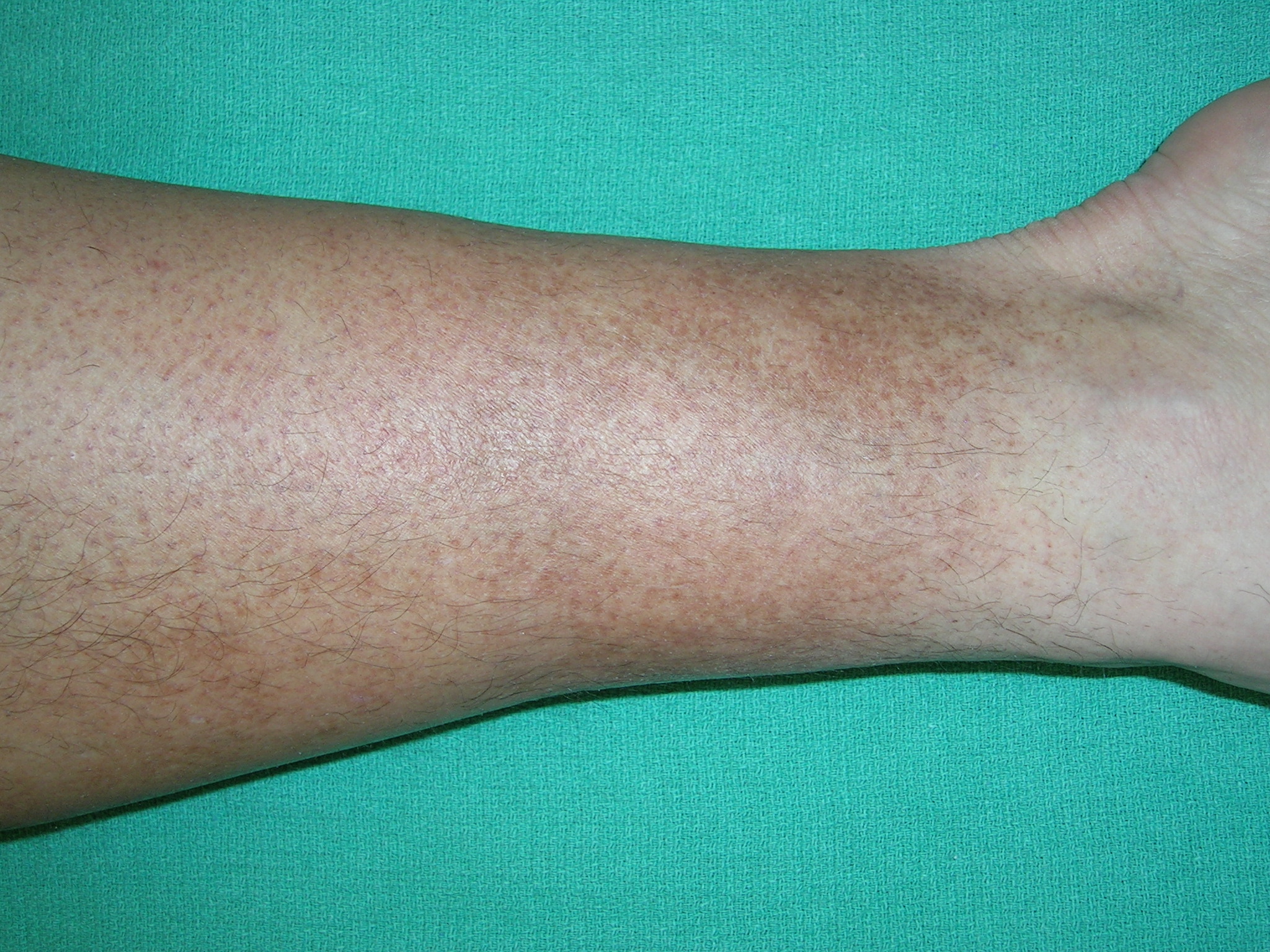Have you noticed changes in the color of your skin on your legs? From slight shifts in shade to more noticeable dark or light patches, leg discoloration is a common concern. It can be triggered by various factors, ranging from simple sun exposure to more complex circulatory issues. This comprehensive guide will delve into the potential causes of leg discoloration, explore effective treatments, and offer preventive strategies to maintain healthy, vibrant-looking skin.
Decoding Leg Discoloration: What’s Behind the Changes?
Several factors can contribute to changes in leg skin color. These range from minor injuries to underlying health conditions.
Circulatory Concerns
Your circulatory system is responsible for delivering oxygen and nutrients throughout your body. When blood flow is compromised, it can manifest as skin discoloration.
- Venous Insufficiency: When blood struggles to return from the legs to the heart, it can pool in the veins, causing a brownish discoloration known as hemosiderin staining. The legs may also appear bruised, purplish, or swollen. This can sometimes lead to stasis dermatitis, a persistent skin inflammation. Learn more about signs of bad egg quality, as diet plays a role in overall circulatory health..
- Peripheral Artery Disease (PAD): PAD restricts blood flow to the legs. This can result in pale or bluish skin, particularly in the feet and lower legs. The affected area might also feel cool to the touch.
Skin Conditions
Various skin conditions can also cause discoloration on the legs.
- Eczema: This inflammatory skin condition can cause red, itchy patches, and the affected skin may become discolored over time. There are different types of eczema, each with its own set of triggers and characteristics.
- Psoriasis: Psoriasis is characterized by an overproduction of skin cells, resulting in raised, red, scaly patches. These patches can sometimes be itchy or painful.
- Vitiligo: Vitiligo causes the skin to lose pigment, leading to the development of white patches. The exact cause of vitiligo is unknown, but it’s thought to be an autoimmune disorder.
Other Contributing Factors
Beyond circulation and skin conditions, other factors can contribute to leg discoloration:
- Trauma: Bruises, resulting from injury to blood vessels under the skin, cause discoloration that typically progresses from bluish-black to green, yellow, and brown as it heals.
- Sun Exposure: Sunburn causes temporary redness and inflammation. Over time, repeated sun exposure can cause hyperpigmentation, leading to darker patches of skin.
- Medications: Some medications, including certain antimalarials and chemotherapy drugs, can cause skin discoloration as a side effect.
- Birthmarks: These are congenital skin markings that can vary in color and size.
- Hormonal Changes: Certain hormonal imbalances, such as Addison’s disease, can contribute to skin darkening. Hormonal fluctuations during pregnancy can also cause discoloration.
Treating Leg Discoloration: Finding the Right Approach
The most effective treatment for leg discoloration depends on the underlying cause. Consult a doctor – especially if the discoloration is accompanied by pain, swelling, changes in sensation, non-healing sores, or rapid spread – as they can diagnose the cause and recommend appropriate treatment options.
Medical Interventions
- Compression Therapy: For venous insufficiency, compression stockings or bandages can improve blood flow and reduce swelling.
- Medications: Medications can address underlying conditions, improve circulation, or target specific skin issues.
- Sclerotherapy & Laser Treatments: These procedures are used for varicose veins, closing off the affected veins.
- Surgery: In severe cases of PAD, surgery may be necessary to restore adequate blood flow.
Topical Treatments
- Prescription Creams: For conditions like eczema and psoriasis, your doctor may prescribe creams to reduce inflammation and itching.
- Over-the-Counter Options: Some over-the-counter creams may help fade discoloration or moisturize dry skin.
Lifestyle Adjustments
- Regular Exercise: Improves circulation, which is crucial for healthy skin.
- Leg Elevation: Raising your legs above heart level can reduce swelling and improve blood flow.
- Sun Protection: Use sunscreen with an SPF of 30 or higher and wear protective clothing.
- Healthy Weight: Maintaining a healthy weight reduces strain on veins.
- Avoid Prolonged Standing or Sitting: Take breaks to move around and stretch.
Preventing Leg Discoloration: Proactive Steps for Healthy Skin
Many causes of leg discoloration can be prevented with proactive measures:
- Sun Protection: Consistent sun protection is vital to prevent discoloration related to sun damage.
- Manage Underlying Conditions: Keeping conditions like diabetes under control can improve circulation and skin health.
- Healthy Lifestyle: A balanced diet, regular exercise, and a healthy weight support good circulation and skin health.
- Avoid Prolonged Standing/Sitting: Take breaks to move around and improve blood flow.
- Compression Stockings: If you’re prone to circulation problems, your doctor may recommend compression stockings.
What Causes Discoloration of the Skin on the Legs?
Leg discoloration can arise from a variety of factors. Skin conditions, sun exposure, circulatory problems, and even certain medications can all play a role. Here’s a deeper look:
Skin Conditions
- Psoriasis: This auto-inflammatory condition leads to a rapid buildup of skin cells, forming raised, red, scaly patches.
- Eczema: This group of inflammatory skin conditions can cause itchy, discolored patches.
- Vitiligo: This condition causes loss of skin pigment, resulting in distinct white patches.
Environmental Factors
- Sunburn: Overexposure to the sun’s UV rays damages the skin, causing redness and potentially long-term discoloration. Repeated sunburns increase the risk of skin cancer.
Vascular Issues
- Varicose Veins: These enlarged, twisted veins appear blue or purple and are often accompanied by aching and heaviness in the legs.
- Venous Disease: This broader term encompasses varicose veins and other conditions affecting vein function, leading to skin changes such as discoloration, especially around the ankles and lower legs. It’s important to consider arterial diseases as well, as these can also impair blood flow.
- Deep Vein Thrombosis (DVT): This serious condition involves a blood clot in a deep vein, usually in the leg, causing swelling, pain, redness, and warmth.
- Thrombophlebitis: Similar to DVT, this involves vein inflammation, often due to a blood clot, causing pain, swelling, and redness.
Other Factors
- Birthmarks: These can be pigmented or vascular, varying in appearance and sometimes changing over time.
- Medications: Certain medications, such as minocycline, some chemotherapy drugs, and birth control pills, list skin discoloration as a potential side effect.
- Hormonal Imbalances: Addison’s disease, a hormonal disorder, can cause skin darkening. Hormonal changes during pregnancy can also affect skin pigmentation.
- Injuries: Bruises from trauma cause temporary discoloration as blood collects beneath the skin. More severe injuries can result in scarring, which can also affect skin color and texture.
- Lymphatic Obstruction: Blockages in the lymphatic system can cause swelling and changes in skin color in the affected area.
- Venous Insufficiency: When veins in the legs don’t function properly, blood may pool, leading to swelling, pain, skin discoloration (often a brownish tinge), and varicose veins. Over time, this can develop into venous stasis dermatitis.
- Hematoma: A hematoma is a collection of blood outside of blood vessels, causing swelling, pain, and bruising.
It’s crucial to remember that medical knowledge is always evolving. Researchers are constantly exploring new theories and refining our understanding of these conditions. If you’re concerned about skin discoloration on your legs, consult a healthcare professional. They can help determine the cause and recommend the appropriate course of action.
How to Get Rid of Discoloration on Lower Legs
Dealing with discoloration on your lower legs requires understanding the underlying cause and adopting a targeted approach. Here’s a breakdown of strategies:
Home Remedies and Lifestyle Changes
- Exfoliation: Gentle exfoliation can help remove dead skin cells, revealing fresher, brighter skin underneath. Avoid harsh scrubs, as these can irritate the skin and worsen discoloration.
- Moisturizing: Keeping skin hydrated can improve its overall appearance and reduce the prominence of discoloration. Look for moisturizers with ingredients like ceramides and hyaluronic acid.
- Sun Protection: Protecting your skin from the sun’s harmful UV rays is paramount. Always apply sunscreen with an SPF of 30 or higher, even on cloudy days.
- Avoid Harsh Chemicals: Certain chemicals in skincare products can irritate skin and potentially worsen discoloration. Opt for gentler products with fewer additives.
Medical Treatments
If home remedies aren’t effective, consult a dermatologist. They can diagnose the cause and suggest stronger treatments:
- Prescription Creams: Prescription-strength creams containing hydroquinone or retinoids can help lighten dark spots and improve skin tone.
- Laser/IPL Treatment: Laser and intense pulsed light (IPL) therapies can target and reduce discoloration, often improving skin texture as well.
- Treatment for Underlying Conditions: If the discoloration is related to an underlying health condition like venous insufficiency or PAD, treating that condition is crucial.
- Hemosiderin Staining Treatment: Specific treatments for hemosiderin staining, a common cause of brown discoloration related to vein problems, include hydroquinone-based creams, sometimes in specialized formulations for use on legs. Your doctor can recommend the best option.
Combining Strategies for Best Results
Often, the most effective approach involves a combination of lifestyle changes, medical interventions (if necessary), and a consistent skincare routine. Be patient and consistent with your approach, and don’t hesitate to seek professional guidance if needed.
What Does a Circulation Rash Look Like?
Circulation rashes can manifest in different ways, depending on the underlying cause. It’s important to be aware of the varying appearances to help with early identification:
Livedo Reticularis
- Appearance: This rash appears as a lacy or net-like pattern on the skin, often with reddish, bluish, or purplish hues. It can sometimes have a marbled appearance.
- Cause: Livedo reticularis is typically caused by changes in blood flow near the skin surface. While it can be harmless, it might also be associated with underlying conditions.
Stasis Dermatitis
- Appearance: Stasis dermatitis usually affects the lower legs and can cause the skin to appear discolored, ranging from reddish to brownish or purplish hues. The skin might also look dry, cracked, scaly, or leathery. In more severe cases, it can lead to open sores or ulcers.
- Cause: Stasis dermatitis results from poor circulation, particularly venous insufficiency. It’s characterized by itchy, inflamed skin most commonly on the lower legs.
- Expert Statement: “Stasis dermatitis is a common inflammatory skin condition in individuals with venous insufficiency. The accumulation of blood in the lower limbs increases pressure on the veins, leading to inflammation and itchy, discolored skin. Stammering syllables can sometimes occur in individuals with certain medical conditions that affect circulation.” – Dr. Richu Mary Grace, MBBS
Peripheral Artery Disease (PAD) Related Skin Changes
PAD can cause skin changes that mimic a rash. The skin on the legs or feet may appear unusually cool, shiny, or dry. There may also be hair loss on the legs and feet. Sores, if present, may heal very slowly.
Other Signs of Circulation Problems
Along with skin changes, circulation problems can cause other symptoms, such as swelling in the legs or ankles (especially after standing for extended periods), leg pain or cramping, and a heavy feeling in the legs. If you experience any of these symptoms, especially in combination with skin discoloration, consult a medical professional.
By understanding the different appearances of circulation-related skin changes and their associated symptoms, you can be better prepared to seek medical attention when needed. Ongoing research continually adds to our understanding of these conditions, so it’s beneficial to stay informed and consult reliable medical sources for the most current information.
- Why Glass Boxes for Lunch Are Trending for Meal Prep - December 17, 2025
- Bento Box Glass Offers Practical, Eco-Friendly Meal Storage - December 16, 2025
- The Best Bento Box Price For Your Perfect Packed Lunch - December 15, 2025










